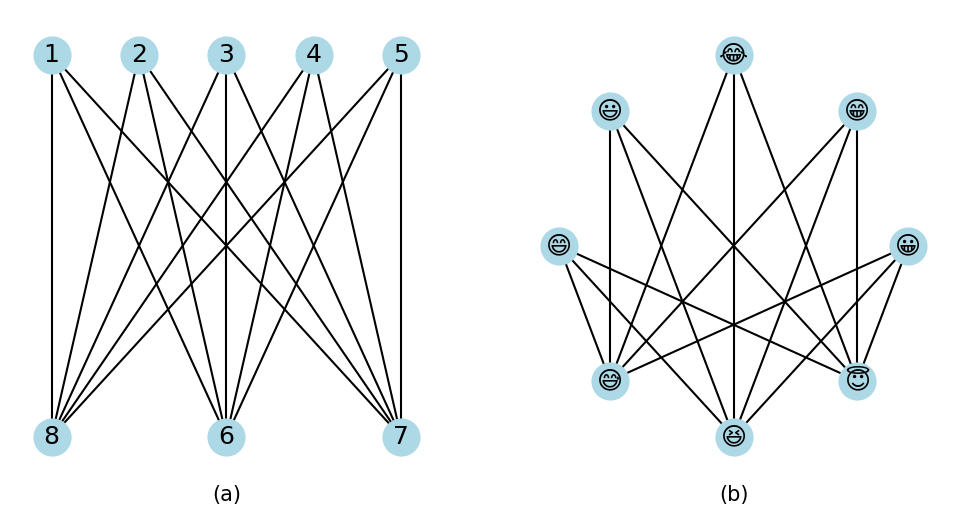Isomorphism
1.1. Isomorphism#
Two graphs \(G\) and \(H\) are identical, written as \(G = H\), if all their components are the same, that is, \(V(G) = V(H)\), \(E(G) = E(H)\) and \(\psi_G = \psi_H\). Identical graphs of course share the same properties. However, a graph \(H\) does not necessarily have to be exactly \(G\) to preserve all its properties. The labels of the vertices and edges are immaterial.
Definition 1.1
Two graphs \(G\) and \(H\) are said to be isomorphic, written as \(G \cong H\), if there exist bijections \(\theta: V(G) \to V(H)\) and \(\phi: E(G) \to E(H)\) such that
The ordered pair \((\theta, \phi)\) is called an isomorphism between \(G\) and \(H\).
[Bondy and Murty, 1976] includes the reverse direction of (1.1) in the definition, that is,
But the reverse direction is redundant. To see this, we suppose that \(\psi_H(\phi(e)) = \theta(u) \theta(v)\) and \(\psi_G(e) = xy\). By (1.1), we have \(\psi_H(e) = \theta(x) \theta(y)\). It then follows that \(\theta(u) \theta(v) = \theta(x) \theta(y)\). We have either \(\theta(u) = \theta(x)\), \(\theta(v) = \theta(y)\), or \(\theta(u) \theta(y)\), \(\theta(v) = \theta(x)\). Because \(\theta\) is a bijection, either \(u=x\), \(v=y\), or \(u=y\), \(v=x\). Either way, we have \(uv = xy\). Therefore, \(\psi_G(e) = x y = u v\), which proves the reverse direction \(\Leftarrow\).
For simple graphs, there is no need to find a bijection between edges once the bijection \(\theta\) between vertices is established.
Proposition 1.1
Let \(G\) and \(H\) be simple graphs. Then \(G \cong H\) if and only if there exists a bijection \(\theta: V(G) \to V(H)\) such that
Proof. (Necessity) Suppose that there exist \(\theta\) and \(\phi\) satisfying (1.1). If \(e = u v \in E(G)\), then by (1.1), \(\psi_H(\phi(e)) = \theta(u) \theta(v)\), which implies \(\theta(u) \theta(v) \in E(H)\).
(Sufficiency) Define \(\phi: E(G) \to E(H)\) by
We need to show \(\phi\) is bijective. Suppose \(\phi(u v) = \phi(x y)\). We have \(\theta(u) \theta(v) = \theta(x) \theta(y)\). Applying a similar argument we used in the previous comments, we will finally obtain \(u v = x y\), which means \(\phi\) is injective. On the other hand, for any edge \(f \in H\). Write \(f = ij\)(i.e., \(\psi_H(f) = ij\)). Then because \(\theta\) is bijective, there exist \(u, v \in V(G)\) such that \(\theta(u) = i\) and \(\theta(v) = j\). Hence, \(\phi(u v) = ij\), which implies \(\phi\) is surjective.
If \(\psi(e) = uv\), i.e., \(e = uv \in E(G)\), then we have \(\theta(u) \theta(v) \in E(H)\) by (1.2). Equivalently, \(\psi_H(\phi(e)) = \theta(u) \theta(v)\).
A complete bipartite graph is a simple bipartite graph with bipartition \((X, Y)\) in which each vertex in \(X\) is incident with each vertex in \(Y\). That is, if \(x \in X\) and \(y \in Y\), then \(xy \in E\). If \(\abs{X} = m\) and \(\abs{Y} = n\), we often use the symbol \(K_{m,n}\) to denote this complete bipartite graph. (See Fig. 1.1.) Note that this implicitly implies that the complete bipartite graph is unique in some way since we can represent it with a common symbol. Indeed, it is unique up to isomorphism, as we will show in the next proposition.

Fig. 1.1 Both (a) and (b) are \(K_{5,3}\).#
Proposition 1.2
Let \(G[X, Y]\) and \(H[U, V]\) be two complete bipartite graphs with \(\abs{X} = \abs{U}\) and \(\abs{Y} = \abs{V}\). Then \(G \cong H\). In other words, a complete bipartite graph is unique up to isomorphism if the sizes of its two vertex sets in bipartition are determined.
Proof. Since \(\abs{X} = \abs{U}\) and \(\abs{Y} = \abs{V}\), we can find a bijection \(\theta: V(G) \to V(H)\) in such a way that \(\theta\) maps each point in \(X\) onto \(U\), and each point in \(Y\) onto \(V\). Then for an edge \(xy \in E(G)\), we have \(\theta(x)\theta(y) \in E(H)\) since there has to be an edge connecting \(\theta(x) \in U\) and \(\theta(y) \in V\) by the definition of complete bipartite graphs. This proves \(G \cong H\) by Proposition 1.1.
